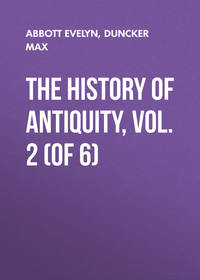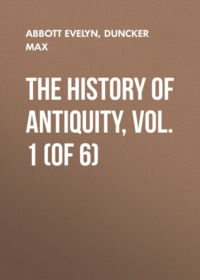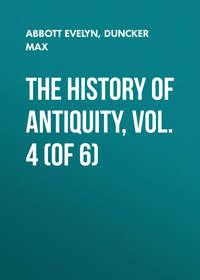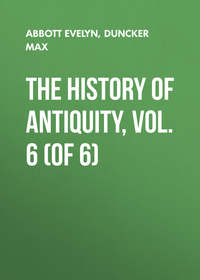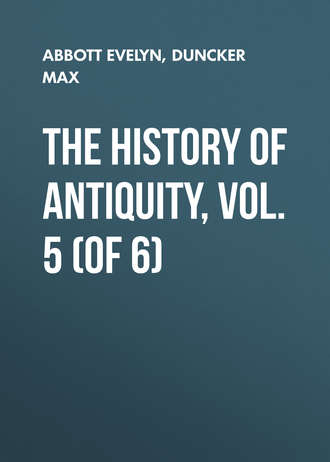 полная версия
полная версияThe History of Antiquity, Vol. 5 (of 6)
In any case the Persians, after the overthrow of Media, were far from possessing the dominion over Asia. In Nicolaus, it is true, when the news is spread abroad that Astyages has retired from Persia and has fled before Cyrus in the first battle in Media, the chief of the Hyrcanians comes with 50,000 men, to pay homage to Cyrus as king; he is followed by the chiefs of the Parthians, Sacæ, and Bactrians, and then by the remaining nations. But as a fact the course of things seems to have been different. If the princes and natives who were subject to the Medes were ready to throw off their dominion as soon as they were defeated by the Persians, they were hardly inclined to recognise Cyrus as sovereign in the room of Astyages. Herodotus tells us that Cyrus subjugated the Bactrians and Sacæ, and Upper Asia, one nation after the other, and puts these conquests after the Lydian war.563 Xenophon represents the Hyrcanians as joining Cyrus at an early date, and the Cadusians follow their example, which harmonises with the view taken in the Persian poems of the hatred of the Cadusians to the Medes. In Xenophon and Ctesias the Sacæ are the allies of Cyrus as early as 549 B.C.564 If Astyages receives the satrapy of the Hyrcanians in Justin, this nation and the Parthians, who were still nearer neighbours of Media, must have been among those who were subject to Cyrus.
In Ctesias, Cyrus after the conquest of Astyages marches against the Bactrians; the battle was undecided. But when they found that Astyages was the father and Amytis the wife of Cyrus, the Bactrians voluntarily submitted to Amytis and Cyrus. Then Cyrus conquered the Sacæ, and took their king Amorges captive. We remember that, according to Herodotus' statement, the proper name of the Sacæ was Amyrgians, and in the inscriptions of Darius we found the Çaka Humavarka. The name Amorges seems to be borrowed from the Amyrgians. When Amorges had been defeated and taken captive by Cyrus, his wife Sparethra, as she is called in Ctesias, collected the Sacæ and took the field with them. Zarinaea, a princess of the Sacæ, had previously fought with great bravery against the Medes, but her achievements are far surpassed by those of Sparethra. With 300,000 men and 200,000 armed women, she went against the Persians, and defeated Cyrus, taking many captives, among whom were Medes of distinction. As a ransom for these Amorges was restored to Sparethra, and there was friendship between Cyrus and the king of the Sacæ, and the latter marched with him to the war against the Lydians. Strabo also speaks of a battle in which Cyrus was defeated by the Sacæ. Being hard pressed on his retreat he abandoned his camp with large stores of every kind, especially of wine. When the Sacæ had enjoyed their spoil, Cyrus fell upon them and massacred nearly all.565
Trogus following Deinon tells us that the nations who were subject to the Medes did not submit to Cyrus. Hence arose many wars. The greater part of these nations he had already overpowered, before he marched against the Lydians, i. e. in the first eight years after the overthrow of Astyages. We may assume that Cyrus, immediately after the dethronement of Astyages, was occupied with bringing the neighbours of Media on the east, north, and west into obedience to the new kingdom. So long as the Parthians, Hyrcanians, Armenians, were independent or in arms against Cyrus, the Medes must be strongly tempted to recover their lost dominion. The Cadusians in Ghilan were subjects of Cyrus; at any rate the name of the city Cyropolis on the Caspian Sea, on the coast of the Cadusians, is a proof that Cyrus placed a fortress there, in order to keep them or their neighbours in check; and under the successors of Cyrus the Cadusians are always mentioned as subjects.566 Then he took the same line towards the west, on which Cyaxares of Media had advanced sixty years previously after driving out the Scythians; he gained Armenia and Cappadocia, and made the Halys the border of his kingdom towards Lydia. In his narrative of the events of the year 549 B.C., Herodotus remarks that the Cappadocians were subject to Cyrus, having previously been subjects of the Medes. It is clear from repeated statements that at this time the Halys was the western border of the empire of Cyrus.567 Xenophon reckons the subjugation of the Armenians, who had been subjects of the Medes, among the earliest achievements of Cyrus; he tells the story in his own manner, and places after this the subjection of the neighbours on the south, the Chaldæans (Gordyæans) who dwelt in the mountains which separate the table-land of Armenia from the hilly country of Assyria. The legends of the Cappadocians conceal their subjugation to Cyrus under supposed links of alliance; Cambyses, the father of Cyrus, had given his own sister Atossa in marriage to Pharnaces, the king of the Cappadocians.568 The extension of the Persian dominion to the east over Parthia and Hyrcania, the subjugation of the Drangians, Gedrosians, and Arachoti, must, in consideration of the observation of Herodotus, that in 548 B.C. Cyrus was intent on military preparations against the Bactrians and Sacæ, and the urgent difficulties which at that time summoned him to the east, be placed in the later years of his reign; in fact, they cannot come earlier than the second decade; which does not, however, make it impossible that Cyrus should have fought against the Bactrians and Sacæ in the first decade.569
Cyrus must have arranged his court and state after the pattern of Media, which in its turn was a copy of the court of the kings of Asshur and Babylon. Ctesias asserts that Petesaces, the eunuch, and after his death Bagapates, another eunuch, had great influence with Cyrus.570 The abode of Achæmenes, Teispes, and Carabyses, the ancient place of assembly and metropolis of the tribe of the Pasargadæ, was changed by Cyrus into a city and fortress; there he built his palace, in which he deposited the spoil of his wars, and collected his treasures.571 The new kingdom rested on the power of the Persians; they alone had to pay no tribute to the king; they formed the nucleus of the army; the leaders and satraps were mainly chosen from them. But Cyrus was obviously anxious to reconcile the Medes, next to the Persians, with the change in affairs, and win their aid. This design lay at the base of his treatment of Astyages and the marriage with his daughter, and scarcely ten years after the fall of the Median kingdom, we find Medes at the head of the army of Cyrus. The clemency of Cyrus towards the other subject nations is also extolled. Herodotus vouches for the fact that he laid no fixed tribute upon them, but left it to themselves to fix the amount of their yearly contributions. Of all men, Xenophon says, Cyrus made the largest presents, and exhibited the greatest liberality towards those who had done him good service, and in this the subsequent kings of Persia followed his example.
According to Xenophon's description, Cyrus was of a kindly disposition, eager to instruct himself, and so ambitious that he shrank from no effort and no danger.572 With the Greeks he passes not only for the founder of the dominion of the Persians, but for the author of excellent arrangements in the kingdom. From this point of view Xenophon wrote his treatise on Cyrus. By his example he wished to prove to the Greeks how the empire over nations could be gained, how a great kingdom could be founded and maintained, how a ruler could command obedience even among those who had never seen him and were separated by great distances. It is a historical romance which he has written on Cyrus; but he knew the Persian empire, and could not advance anything absolutely in contradiction to the current opinion of the Greeks about Cyrus. According to him the relation of Cyrus to the Persians rested on a kind of compact. When his son had subjugated the nations far and wide, Cambyses collected the elders of the Persians and the officers who held the highest places, and told them the Persians had elected Cyrus to be their general, and given him the army; Cyrus had extended their power over Asia, and gained glory among all men; he had made the bravest men in the army rich, and found pay and food for all the soldiers. If this relation were maintained it would be for the advantage of both parties; if, on the other hand, Cyrus sought to rule over the Persians with the same caprice as over other nations, or the Persians should attempt to take the command from him, each would do the greatest harm to the other. Let Cyrus, therefore, undertake to protect Persia and uphold the Persian laws, and the Persians to render Cyrus any service that he needed against rebellion and enemies. "After me," Cambyses concludes, "Cyrus will be king, and whenever he comes to Persia he will offer for you the sacrifice which I am offering now. If he is in a foreign land, it will be best for the noblest of our family to offer sacrifices to the gods." "What Cambyses proposed was approved by Cyrus and the Persians with invocations to the gods, and the arrangement is still observed on both sides."573 Plato even puts Cyrus on the same level as Lycurgus, the founder of the constitution of Sparta. He gives Dion the choice of rivalling the ancient Lycurgus or Cyrus, or any one else who may be distinguished by moral excellence and political wisdom.574 According to the Laws, Cyrus, brought up from his youth in the camp and surrounded by danger, became a skilful general, and as a ruler kept before his eyes the prosperity of the state. In the same book we are told that the monarchical form of government attained its most complete state among the Persians, and the democratic among the Athenians. But as the Persian state pursued absolute dominion, and the Attic uncontrolled freedom, neither discovered the correct limit; though in ancient times they had observed due moderation. At the time of Cyrus the Persians were midway between slavery and freedom. At first they were free, then they became the lords of others. But while ruling they had given the subjects a share in freedom, and treated them on an equal footing. For this reason the warriors were devoted to their general and ready to plunge into danger. And if an intelligent man appeared, who could give wise counsel, Cyrus gave him liberty to speak; and as he honoured those who knew how to give advise, every opinion was made use of for the common good, and the Persians of that day succeeded in everything by freedom, concord, and common deliberation.575
END OF VOL. V1
Ritter, "Erdkunde," 7, 234-240; 8, 721.
2
Herod. 1, 125; 7, 85; Lassen, "Z. D. M. G." 6, 55. Herodotus reckons the Paretaceni among the tribes of the Medes (1, 101); the Sagartians, whom he represents as armed partly like Persians, partly like Pactyans, with the Carmanians, he places among the Persians. Yet the nomad Sagartians seem rather to have had relations with the Medes than the Persians; for, according to the inscription of Behistun, a rebel obtains a following among the Sagartians by giving himself out to be a descendant of Cyaxares, the Median king. Ptolemy places the Sagartians in Media; cf. Plin. "Hist. Nat." 6, 29.
3
Arrian, "Anab." 6, 22 ff.; "Ind." 25, 26; Curtius, 9, 10, 5.
4
Behistun, 1, 6; Persep. 1, 17; Herod. 3, 91.
5
Strabo, p. 711; Arrian, "Ind." 25, 26; "Anab." 6, 23.
6
Arrian, "Anab." 3, 27; Diod. 17, 81; Strabo, p. 724.
7
Vol. IV. p. 33.
8
The city of Kapisakani, which Darius, according to the inscription of Behistun (3, 9, 1), conquered in the land of the Arachoti, is no doubt the Capissa of Pliny, in the district of Capissene; "Hist. Nat." 6, 25. Pliny speaks of the city and river of Cabul as belonging to the Arachoti. The inhabitants of the southern slope of the Hindu Kush are known to the Greeks as Paropanisadæ. The explanation of the name by Paropanisos (Paropamisus), Paropanishadha, given by Lassen, is quoted in Vol. IV. p. 21, n. 2. In the Babylonian text of the inscription of Behistun, the Gandaras of the Persian text are called Parupanisana. In the narrower sense the name denotes the south-western part of the range of the Hindu Kush, the group which forms the cradle of the Herirud and Hilmend, the modern Ghuristan, to the west of the plateau of Ghasna.
9
Lassen, "Indische Alterthumskunde," 1, 428. Fr. Müller ("Ueber die Sprache der Afghanen") is of the opinion that the Afghan does not come between Indian and Persian, but belongs to the Iranian stem, and the Afghan has preserved the old Bactrian relations of sound more faithfully than the Persian, and thus shows itself to be a direct descendant of the old eastern dialect of Iran. Trump proves that Afghan is an ancient independent language of strong Indian type. "Z. D. M. G." 21, 10 ff.
10
Strabo, pp. 508, 514, 724; Plin. "Hist. Nat." 6, 29; Diod. 17, 75.
11
Ritter, "Erdkunde," 8, 425 ff.
12
Isid. "Charac. Mans. Parth." 10-14. The Parthians rose with the Hyrcanians against Darius; Parthians and Hyrcanians formed one satrapy. The Parthians are the Pahlav of Moses of Khorene, the Pehlew of later writers. The mention of them in the inscriptions of Darius proves that they are not a later immigrant Scythian, i. e. non-Arian, nation, as Justin, Strabo, and others maintain. The cities which the inscription of Behistun mentions in Parthia (2, 95; 3, 4), Viçpauzatis and Patigrabana, we cannot fix more definitely; Ammian (23, 6) mentions Patigran in Media. Parthunisa, with the graves of the Parthian kings, mentioned in Isidorus, "which the Greeks call Nisæa," is Parthava-Niçaya, and must be sought for near the modern Nishapur. It must be the Niça which the Vendidad places between Mouru and Bakhdhi. Justi, "Beitrage," 2, 6 compares Isidorus' Βατζιγράβαν, ὅ ἐστι τελώνιον.
13
Curt. 7, 4.
14
Strabo, pp. 118, 516, 682; Arrian, "Anab." 3, 29. On Aornus, cf. Vol. IV. p. 395.
15
Ptolem. 6, 11; 8, 7; Strabo, pp. 514, 516; Arrian, "Anab." 3, 29; 4, 1, 16, 22; Plin. "Hist. Nat." 6, 17, 18; Steph. Byz. sub voc. Firdusi mentions a hero Zarasp.
16
Elphinstone, "Kabul," 2, 213, 214.
17
Strabo, loc. cit.
18
Herod. 7, 62; Strabo (pp. 516, 517, 724) includes in Ariana, Gedrosia, Arachosia, Drangiana, Paropanisus, Aria, Parthia, and Caramania. Cf. Pausan. 2, 3, 8.
19
Diod. 1, 94. Damascius ("De Primis Principiis," p. 384) speaks of the Μάγοι δὲ καὶ πᾶν τὸ ἅριον γἑνος.
20
"Vendid." 19, 132; "Mihr Yasht," 4, 13; "Tistar Yasht," 9, 56, 60.
21
Naksh-i-Rustem, a., 14.
22
Herod. 7, 61. Cf. Steph. Byz. Ἀρταία.
23
On the tribe of the Brahuis in the south-east, on this side of the Indus, cf. Vol. IV. p. 10.
24
Haug, "The book of Arda Viraf," p. xxv. Mordtmann has shown on the coins of the Arsacids and Sassanids the stages between the older forms and the language of Firdusi; "Z. D. M. G." 4, 84 ff., 8, 9 ff. On the forms of the Old Bactrian on the coins of the Græco-Bactrian and Indo-Scythian princes: Lassen, "Indische Alterthum." 22, 834 ff. Spiegel, "Parsigrammatik," s. 116 ff.
25
It has been recently proved that the inhabitants of the mountain country between Cabul and Herat, the Aimaks and Hazares, speak Persian.
26
Polyb. fragm. 34 f.; below, p. 26.
27
Above, p. 6; Vol. III. p. 3, "Zikruti in rugged Media I added to the land of Assyria;" ib. p. 4.
28
Vol. III. p. 77.
29
Herod. 1, 153, 177, 201, 204.
30
Strabo, p. 517; Arrian, "Anab." 4, 23; Plin. "H. N." 6, 18; Ptolem. 6, 12.
31
Ctes. fragm. Pers. c. 12.
32
Behist. 1, 6; Persep. 25; Naksh-i-Rustem, 12-14.
33
Herod. 3, 91, 92.
34
Vol. I. p. 285. The amount is about 2096 thalers.
35
Behist. 2, 14-16; 3, 10-12.
36
Herod. 7, 64, 82; 9, 113.
37
Herod. 8, 93.
38
Diod. 11, 69; Ctes. Pers. ecl. 31.
39
Arrian, "Anab." 3, 21.
40
Arrian, loc. cit. 3, 29.
41
Justin. 41, 4.
42
As was shown in Vol. IV. p. 278, the Vishnu Purana represents the sacrificial horse of Pushpamitra, who sat on the throne of Magadha between 178 and 142 B.C. (Vol. IV. p. 550), to have been carried off by an army of Yavanas on the right bank of the Indus, and then restored. The dominion of the Græco-Bactrian princes in the East existed from 200 to 150 B.C.
43
Strabo, p. 516. I need not prove that Ἰωμάνης must be read here for Ἰσάμος, or that Σαραόστου παραλία is Surashtra; cf. Wilson, "Ariana antiq." p. 281. Apollodotus, Apaladata on the Arian legends of his coins, is no doubt the Bhagadatta of the Mahabharata, just as the Dattamitra there mentioned is Demetrius; Vol. IV. p. 80, n. Among the Indians Menander appears in the form Milinda.
44
In the year 1843 there were about 1000 Guebre families in Yezd, and a hundred in Kerman. Westergaard, "Avesta," 1, 21: the persecution of 1848 considerably reduced their numbers.
45
Haug, "Pahlavi-Pazand Glossary," pp. 80, 81.
46
"Vendid." 1, 73-76.
47
"Vendid." 1, 46.
48
"Vendid." 19, 130; 1, 50.
49
Burnouf, "Jour. Asiat." 1845, pp. 287, 288. It seems to me doubtful whether we should look for Airyana Vaeja on the sources of the Oxus. The statement in the Bundehesh that Airyana Vaeja was situated beside Atropatene is, however, of very little weight against the fact that the Arians of East Iran are nearest to the Arians of India. I shall return to this point below. The remark in Stephanus, "Ἀριανία, a nation among the Cadusians," would be of some importance if it were taken from Apollodorus of Artemita, and not from the grammarian of that name. The district of Arran on the Kur may possibly be meant.
50
"Vendid." 1, 14-18.
51
"Vendid." 1, 30, 42.
52
"Vendid." 1, 60.
53
"Yaçna," 9, 4.
54
"Vendid." 2, 1-21, after Karl Geldner's translation. [Cf. Darmesteter's translation in M. Müller's 'Sacred Books of the East,' Vol. IV.]
55
"Vendid." 2, 21-43.
56
"Aban Yasht," 9; "Farvardin Yasht," 131; "Bahram Yasht," 40; "Ram Yasht," 23.
57
"Farvardin Yasht," 131 ff.
58
"Yaçna," 9, 30; "Vendid." 20, 11 ff.
59
"Vendid." 20; "Yaçna," 9, 32, 39; "Ram Yasht," 7, 28; "Farvardin Yasht," 136; "Zamyad Yasht," 41 ff. According to the "Mainyo-i-Khard," Kereçaçpa, besides slaying the serpent Çruvar, slew the wolf Kapod, the water demon Gandarsi, the bird Kamak, and kept back much oppression from the world. West, "Mainyo-i-Khard," c. 27.
60
Justi, "Handbuch," s. voc.
61
"Farvardin Yasht," 131.
62
"Farvardin Yasht," 132; "Zamyad Yasht," 71.
63
"Gosh Yasht," 18; "Ashi Yasht," 38.
64
"Aban Yasht," 49; "Gosh Yasht," 18; "Ashi Yasht," 38; "Afrin Zartusht," 7; "Zamyad Yasht," 77; "Ram Yasht," 32.
65
"Aban Yasht," 76, 98; "Ashi Yasht," 46; "Farvardin Yasht," 102; "Ram Yasht," 36.
66
"Aban Yasht," 109, 117; "Farvardin Yasht," 38; "Gosh Yasht," 29, 30; "Ashi Yasht," 50, 81; "Zamyad Yasht," 87.
67
"Aban Yasht," 104-106; "Farvardin Yasht," 142; "Gosh Yasht," 26; "Ram Yasht," 36.
68
"Vendid." 2, 39, 40.
69
Vol. IV. 21 n. Spiegel, "Avesta," 3, Einl. s. 58. The favourite comparison of the enclosure of Yima with the deluge of the Hebrews appears to me anything but apposite. Iran, and still more Bactria, is unsuited to give rise to the legend of a flood. Nor is there any question of the destruction of evil men (if there had been, Yima would have been the most guilty and the least deserving of pardon), but of the end of the golden age, as is shown in the Vendidad, the Yaçna, and the Yashts: the earth becomes more thickly peopled, men and animals do not grow old or die. If we must bring together things which have really no relation to each other, it would be more apposite to compare the paradise of the Hebrews. The reason for the end of the golden age is the guilt of Yima. [Cf. Kuenen, "Religion of Israel," 3, c. 9, E. T.]
70
"Zamyad Yasht," 46.
71
"Rigveda," 1, 158; 10, 8, 5.
72
Westergaard in Weber's "Ind. Studien," 3, 413 ff., 426 ff. Kuhn combines Trita with Triton and Tritogeneia; Hofer's "Zeitschrift," 1, 276, 289.
73
Haug, "Essays," pp. 235, 236.
74
Kuhn, "Beiträge," 4, 44; Haug, "Essays," pp. 235, 236.
75
Strabo, p. 517. [Τοριούαν is a v. l. for Ταπυρίαν.]
76
[Cf. Darmesteter, "Zend-Avesta," Introduction, c. iii.]
77
Haug, "The Book of Arda Viraf," p. 142 ff.
78
Herbedh is the old Bactrian athrapaiti.
79
Haug, "Pahlavi-Pazand Glossary," p. 144, 146.
80
It is found in the so-called "Great Rivayat."
81
Vullers, "Fragmente über die Religion Zoroasters," s. 15-42; Haug, "Essays," p. 125.
82
Quatremère, "Journ. des Savants," 1840, p. 413.
83
Clemens Alex. "Strom." p. 598.
84
Diogen. Laert. prooem. The corrupt passage in Athenæus (p. 478) is not a sufficient reason for refusing to accept Hermippus of Smyrna as the author of the treatise on the Magians. Pliny could not quote the Berytian Hermippus.
85
Plin. "H. N." 30, 2.
86
"H. N." 37, 49, 55, 58; 26, 9; 27, 35; 28, 19, 27; 29, 38; 21, 36.
87
Philon. Bybl. fragm. 9, ed. Müller.
88
Dio Chrysost, ed. Dind. 2, 60.
89
Pausan. 5, 27, 3.
90
"Anab." 7, 11, 8.
91
E. g. the bas-relief on Mount Behistun in the winged victory, which refers to the battle between Vardanes and Gotarzes, between 40 and 50 A.D. [Cf. Rawlinson, "Sixth Monarchy," p. 389, where a sketch of the relief is given.]
92
Poseidonius in Strabo, p. 515; Justin, 42,1.
93
Herodian, 4, 30.
94
Plut. "Crassus," c. 29; "Anton." c. 47; Joseph. "Antiq." 18, 9, 3; Justin (12, 3), and Horace ("Ep." 1,2, 112), are of another opinion in regard to the latter point.


